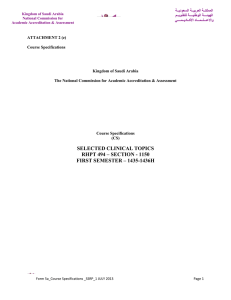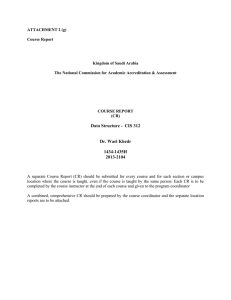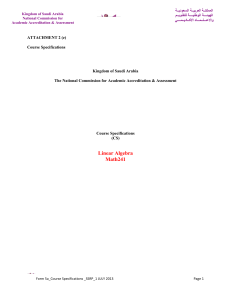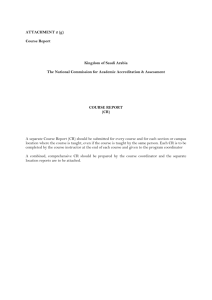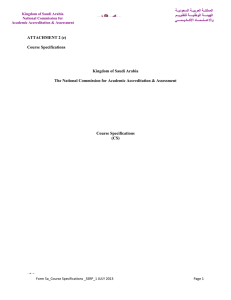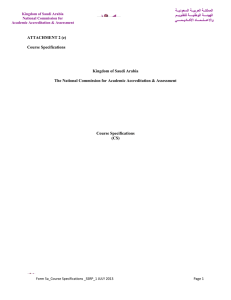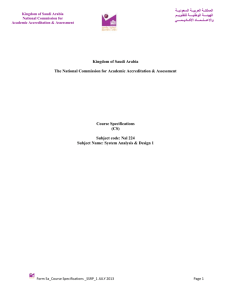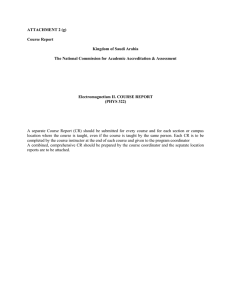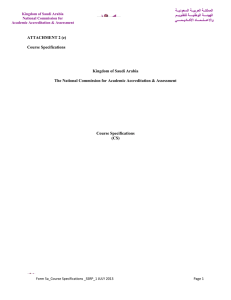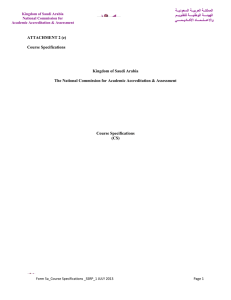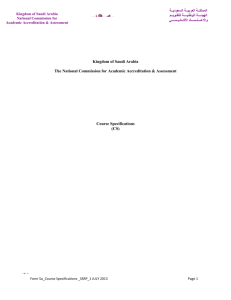Kingdom of Saudi Arabia National Commission for Academic
advertisement
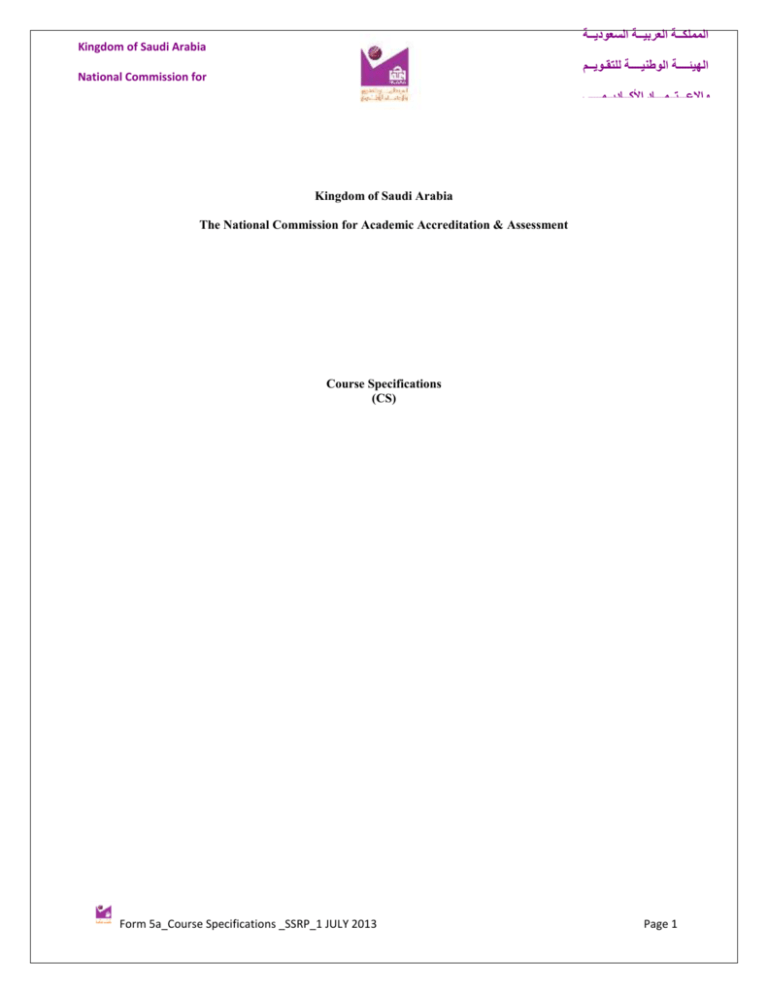
المملكــة العربيــة السعوديــة Kingdom of Saudi Arabia الهيئــــة الوطنيــــة للتقـويــم National Commission for واالعـــتــمـــاد األكــاديــمــــي Academic Accreditation & Assessment Kingdom of Saudi Arabia The National Commission for Academic Accreditation & Assessment Course Specifications (CS) Form 5a_Course Specifications _SSRP_1 JULY 2013 Page 1 المملكــة العربيــة السعوديــة Kingdom of Saudi Arabia الهيئــــة الوطنيــــة للتقـويــم National Commission for واالعـــتــمـــاد األكــاديــمــــي Academic Accreditation & Assessment Course Specifications Institution: King Khalid University, Kingdom of Saudi Arabia College: Department: Date of Report 28-05-2015 College of Science and Arts for Girls, Khamis Mushait(1) English A. Course Identification and General Information 1. Course title and code: (Phonetics) ENG 321 2. Credit hours 3 Hours 3. Program(s) in which the course is offered. Bachelors of Arts 4. Name of faculty member responsible for the course Ms Mannujan Mohini Sudha 5. Level/year at which this course is offered: 5th level/3rd year 6. Pre-requisites for this course (if any) 7. Co-requisites for this course (if any) 8. Location if not on main campus 9. Mode of Instruction (mark all that apply) a. Traditional classroom Khamis Mushait What percentage? 100 b. Blended (traditional and online) What percentage? 55 c. e-learning What percentage? d. Correspondence What percentage? f. Other yes What percentage? Comments: N/A Form 5a_Course Specifications _SSRP_1 JULY 2013 Page 2 المملكــة العربيــة السعوديــة Kingdom of Saudi Arabia الهيئــــة الوطنيــــة للتقـويــم National Commission for واالعـــتــمـــاد األكــاديــمــــي Academic Accreditation & Assessment B Objectives To describe the articulatory mechanism involved in the production of speech sounds. To study major distinctions and parameters employed in the classification of speech sounds.. To include manner vs. place of articulation, vowel vs. consonant sounds, voiceless vs. voiced consonants ...etc.in these distinctions. To introduce the sound systems of both the L1 & L2, i.e. Arabic and English, To give training to the students in phonetic transcription of spoken (English) texts using broad IPA (International Phonetic Association) symbols C. Course Description (Note: General description in the form to be used for the Bulletin or handbook should be attached) 1. Topics to be Covered List of Topics No. of Weeks 2 Contact Hours 6 1. Introduction to phonetics, branches of phonetics, spelling and speech sounds; letters and phonemic symbols, British and American pronunciation 2. Organs of speech, stages of making speech sounds, vowels and consonants 2 6 3. Consonants: states of the glottis, places of articulation, manner of articulation 3 9 4. practice and exercises on consonants articulation and transcription 1 3 5. Vowels: states of the muscles (tense vs lax vowels), Tongue vertical and horizontal movements, states of the lips (rounded versus unrounded), Vowel classification (monothongs, diphthongs, triphthongs) 3 9 6. Practice and exercises on vowels articulation and transcription 1 3 7. Full phonemic transcription words and phrases 1 3 8. The Syllable, strong versus weak syllable 2 6 2. Course components (total contact hours and credits per semester): Lecture Tutorial Laboratory Practical Other: Group Discussion Total Contact Hours 45 - - - - 45 Credit 45 - - - - 45 Form 5a_Course Specifications _SSRP_1 JULY 2013 Page 3 المملكــة العربيــة السعوديــة Kingdom of Saudi Arabia الهيئــــة الوطنيــــة للتقـويــم National Commission for Academic Accreditation & Assessment 3. Additional private study/learning hours expected for students per week. واالعـــتــمـــاد األكــاديــمــــي 2 hours 4. Course Learning Outcomes in NQF Domains of Learning and Alignment with Assessment Methods and Teaching Strategy NQF Learning Domains And Course Learning Outcomes 1.0 1.1 2.0 Course Teaching Strategies Course Assessment Methods Knowledge To define letters and phonemic symbols To write and pronounce the full inventory of phonemic symbols for speech sounds of English To record each speech sounds in terms of their articulatory gestures. find similarities and differences between various individual speech sounds. To list speech sounds into sets and natural classes in terms of shared articulatory features To recognize written words and phrases into phonemic transcription To reproduce words and phrases correctly from their phonemic transcription such as in the dictionary entries Cognitive Skills 2.1 To interpret critically and analytically To explain standard and academic English To predict sound judgments after reading some information. • Lectures • Class discussion • Assignments • work Collaborative learning/Team • Elearning • Lectures for teaching students how to read attentively and critically Class participation Quizzes Class presentations. Two midterm exams and final exam Class participation Presentations Midterm exams • Class discussions for teaching students to think independently and engage in group discussions • Encourage individual meetings of students with the instructor to discuss paper topics 3.0 Interpersonal Skills & Responsibility 3.1 To evaluate both reading and writing assignments in due time. Form 5a_Course Specifications _SSRP_1 JULY 2013 Lectures in which students are made aware of the Performance on midterms and final exams are Page 4 المملكــة العربيــة السعوديــة Kingdom of Saudi Arabia الهيئــــة الوطنيــــة للتقـويــم National Commission for واالعـــتــمـــاد األكــاديــمــــي Academic Accreditation & Assessment significance of time management 4.0 Communication, Information Technology, Numerical 4.1 5.0 N/A Psychomotor N/A N/A 5.1 N/A N/A N/A evidence of the student’s ability to recollect and synthesize information Instructor’s assessment of student’s performance and seriousness during individual supervision hours. D. Student Academic Counseling and Support 5. Schedule of Assessment Tasks for Students During the Semester Assessment task (e.g. essay, test, group project, examination, speech, oral presentation, etc.) 1 First midterm exam Week Due 7th week Proportion of Total Assessment 20% 2 Second midterm exam 13th week 20% 3 Quizzes and assignment various weeks 10% 4 Final exam 16th week 50% 1. Arrangements for availability of faculty and teaching staff for individual student consultations and academic advice. (include amount of time teaching staff are expected to be available each week) 4 (Four) hours per week for individual student counselling and academic advice. E. Learning Resources 1. Required Text: Carr, Philip. 1999. English Phonetics & Phonology: An Introduction. London: Blackwell. (Chapters 5 11). List Essential References Materials (Journals, Reports, etc.) 2. Evelyn J. Sewell (2000)Educational research and integrative introduction, Mc Graw – Hill. List Recommended Textbooks and Reference Material (Journals, Reports, etc) 3. 1- Borg. W, Gall, M. & Joyce G.(2002) Educational Research: an introduction, Longman List Electronic Materials (eg. Web Sites, Social Media, Blackboard, etc.) 4. Students are advised to search relevant websites according to their topics. Form 5a_Course Specifications _SSRP_1 JULY 2013 Page 5 المملكــة العربيــة السعوديــة Kingdom of Saudi Arabia الهيئــــة الوطنيــــة للتقـويــم National Commission for واالعـــتــمـــاد األكــاديــمــــي Academic Accreditation & Assessment 5. Other learning material such as computer-based programs/CD, professional standards or regulations and software. 6. PPT slides F. Facilities Required Indicate requirements for the course including size of classrooms and laboratories (i.e. number of seats in classrooms and laboratories, extent of computer access etc.) 1. Accommodation (Classrooms, laboratories, demonstration rooms/labs, etc.) Classroom (Lecture room) 2. Computing resources (AV, data show, Smart Board, software, etc.) Internet 3. Other resources (specify, e.g. if specific laboratory equipment is required, list requirements or attach list) NONE G Course Evaluation and Improvement Processes 1 Strategies for Obtaining Student Feedback on Effectiveness of Teaching Confidential completion of standard course evaluation questionnaire by students at the end of each semester Occasional student-faculty meetings to get students’ feedback 2 Other Strategies for Evaluation of Teaching by the Program/Department Instructor In-class observation by other colleagues Peer observation Observation by external experts 3 Processes for Improvement of Teaching Workshops by internal and external experts Coordination between teachers of different sections of the same course Training and orientation for new instructors of the course 4. Processes for Verifying Standards of Student Achievement (e.g. check marking by an independent member teaching staff of a sample of student work, periodic exchange and remarking of tests or a sample of assignments with staff at another institution) Establishing guidelines for uniformity, objectivity, and fairness of evaluation standards by the department Mutual checking of random samples of examination papers by coordinators and other teachers of the same course 5 Describe the planning arrangements for periodically reviewing course effectiveness and planning for improvement. Regular meetings between teachers and course coordinator Regular meetings by The Curriculum Review Committee Departmental council meetings to discuss and finalize proposals made by the Curriculum Review Committee Faculty or Teaching Staff: Ms. Mannujan Mohini Sudha Signature: _______________________________ Date Report Completed: ____________________ Received by: _____________________________ Dean/Department Head Signature: _______________________________ Date: _______________ Form 5a_Course Specifications _SSRP_1 JULY 2013 Page 6 Kingdom of Saudi Arabia National Commission for Academic Accreditation & Assessment Form 5a_Course Specifications _SSRP_1 JULY 2013 المملكــة العربيــة السعوديــة الهيئــــة الوطنيــــة للتقـويــم واالعـــتــمـــاد األكــاديــمــــي Page 7
